Originally known as Broomage or South Broomage House, Carronvale was probably built around 1800 by Alexander Brown junior of Broomage, or his son, James. It does not appear on Roy’s map of 1755. The Browns had held half of the lands of Broomage for some time but it was only in 1777 that Alexander Brown bought the other half from Robert Chalmers. The house was built in the southern portion of Broomage on a slight south-facing slope just to the north of the lade constructed in 1760 by the Carron Company to feed water from the River Carron into its dams. It lay on the east side of a minor road between the villages of Camelon and Broomage which crossed the river by the King’s Ford at Dorrator. From the ford another road branched off to the left to Larbert. The early house seems to have been a typical well-to-do two-storey farmhouse of the period with a symmetrical south façade having a central doorway and a window to either side, with three windows on the first floor. The doorway was enhanced by the provision of pilasters and a consoled cornice. To its west a quadrangular stable block was constructed and is shown on Grassom’s map. It had opposing tall arched entrances on the south and north. Trees were also planted around the policy. James Brown was an agent of the Falkirk Union Bank and was appointed a captain in the newly formed Falkirk Loyal Volunteers on 29 June 1803. In 1818 Broomage was sequestered as a result of the failure of the bank. The seventy acre estate and the mansion were offered for sale at an upset price of £1,900.

The house and lands were sold in 1819 to the Honourable Duncan Robertson of Roehill in Perthshire. Duncan Robertson was a doctor of medicine and made his fortune in Jamaica where he became a member of the Legislative Council – hence the title of Honourable. He used part of his fortune to add two single-storey wings with south-facing bay windows to the house. That on the east was the dining room and also had a bay window on its east side. Some of the interior hardwood for the house was imported from the family estate in Jamaica called ‘Friendship’. A lodge house was erected at the entrance. It was also at this time that the grounds were extensively laid out and the two walled gardens placed to the north of the house. Further tree planting took place and it is possible that the yew which stands to the south-east of the house and the two wellingtonia on the southern axis belong to this period. The changes created a small country seat and called for a change in the name of the estate and house to ‘Carronvale.’ This had more of a poetic ring to it, but unfortunately was already the name of a small mansion in Denny. Duncan Robertson became a Justice of the Peace for the county and sat on the courts at Falkirk. On 17 March 1823 Carronvale House provided a suitable venue for the marriage of Duncan’s daughter, Louisa Ann Robertson, to Rev. Kelly of Southend. It must have seemed that the family had become part of the established minor aristocracy and the Hon Duncan Robertson MD of Carronvale had his portrait painted by Sir Henry Raeburn.

Illus 3: The Original Lodge with later Extensions.
However, Dr Robertson did not have long to enjoy the fruits of his labours and he died prematurely in 1824 leaving Carronvale to his eldest son, Duncan Stewart Robertson, who was only three years old and so the house, fully furnished, was offered for rent in 1826 and again in 1827, via solicitors Russell & Aitken.
“FURNISHED HOUSE IN STIRLINGSHIRE TO BE LET. To be Let for such number of years as may be agreed on, and entered to at Whitsunday first.
THE MANSION HOUSE, OFFICES, GARDEN, and LAWN of CARRONVALE, with whatever number of Grass Parks a tenant may incline. Carronvale lies within about two miles of Falkirk, and is delightfully situated on the banks of the River Carron. The mansion house (which is modern) contains dining-room, drawing-room, parlour, library, and a number of bed-rooms and other conveniences, all in the best order, having been lately painted and thoroughly repaired. The offices are large and complete. The garden contains upwards of a Scots acre, well enclosed with brick walls, and completely stocked with fruit trees in full bearing. And, on the whole, few such comfortable situations for a summer residence are to be met with.
There is a post office in the near neighbourhood, and several stage coaches pass within a few minutes’ walk; and the Edinburgh and Glasgow track boats are also quite at hand.
The furniture of the dwelling house is elegant and substantial, and nearly new.”
(The Scotsman 15 February 1826, 4).
When he came of age Duncan S Robertson received a commission in the 31st Regiment. He served in India and whilst there he met his future wife, Harriette Anne Mary, the third daughter of Hon Colonel David Ogilvy of Clova. They were married on 18 September 1844. After bearing two children she died on 23 April 1849. Meanwhile Captain Duncan Robertson became a JP. Goods for Carronvale House were supplied from the town of Falkirk and this, naturally, included a quantity of beer from James Aitken and Co. Late one summer afternoon, shortly after five o’clock, Alexander Hamilton of the Falkirk Brewery had delivered the goods and was returning via the ford over the River Carron. It was June in 1856 and the river was swollen with recent rains. The horse, man and cart were swept away. The alarm was only raised when the horse was seen swimming near Carron Bridge about two miles downriver. The body of Hamilton was found around 7am the next day.
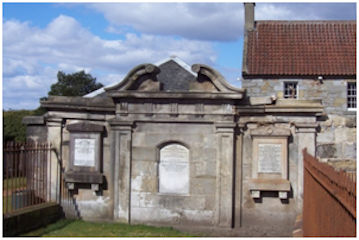
Illus 4: The Robertson Enclosure at Larbert Parish Churchyard.
Captain Robertson, like his father, died young. On 20 October 1856 he breathed his last at Lochmaben Manse aged only 35. His will stipulated that all of his possessions should be divided equally between his two young children, Donald and Julia. Consequently Carronvale was put on the market:
“BEAUTIFUL SMALL ESTATE NEAR LARBERT TO BE SOLD/ THE ESTATE OF CARRONVALE, consisting of nearly 100 Acres of the finest Land.
There is an Excellent and Commodious Modern Mansion House, beautifully situated for a genteel family, with complete set of offices and Large Walled Garden. The Plantations are ornamental and thriving. The Farm is at present Let to an enterprising and respectable tenant, but arrangements may be made for the Proprietor to resume possession, if desired.
So eligible and desirable a Small Estate seldom comes into the market. The Lodge is about half a mile from Larbert Railway Station, from which there is easy access in an hour to Edinburgh and Glasgow.
The Boundaries of the Property will be shown by Mr Ronald, the Tenant of the Farm.”
(Glasgow Herald 24 November 1856, 2).
The sale of the house and 93 acres of land took place on 4 February 1859 at the upset price £7,800.

The layout of the mansion house and its associated designed landscape at this period is shown on the first edition Ordnance Survey map. The lodge house is located near the south-west corner of the policy next to the entrance to the tree-lined drive which ran parallel to the lade before curving northwards towards the house. It then passed in front of the house with the lawn on its right before continuing around the back of the house to the stables. In front of the stables is a stone-lined crescent-shaped detour which might have been a coach wash. The lade was screened by trees and a woodland path ran alongside this screen. The walled gardens were laid out with paths – the western garden probably being for vegetables and the eastern for flowers and fruit trees. To their west was a paddock for the horses and milk cows to graze in. A service drive led from the main road to this paddock and the north side of the stables and the walled gardens.
Carronvale was bought in April 1857 by John Bell Sherriff. He had family connections with the area because his father, George Sherriff, had worked with Carron Company and then with James Watt the steam engineer before going to Russia. John Bell Sherriff was born in St Petersburg in 1821 and came to Scotland when he reached the age of 21 and was employed by his uncle, Christopher Bell, a tea merchant. He lived with his uncle at Abbotshaugh House. He subsequently entered into business as a distiller and married Flora Taylor whose father was a merchant in Islay. He was successful enough to acquire a distillery in Campbeltown.
John Bell Sherriff was a staunch supporter of the volunteer movement and in 1862 became the first captain of the 12th Stirlingshire Rifle Volunteers. He was soon forced to retire due to age and other commitments but undertook much of the administration of the unit. In July 1869 65 rank and file, as well as the band, of the 12th Stirlingshire (Carron) Rifle Volunteers proceeded to Carronvale under the command of Lt Gillespie. They marched round the mansion house and drew up in the front of the door. Each had 15 rounds of blank cartridge and performed a variety of manoeuvres consisting of file and volley firing, manual and platoon exercise and skirmishing. Gooseberries from the garden were supplied as part of the refreshments.

After seven years at Carronvale John Bell Sherriff decided to take over the running of Carronvale Farm from his tenant, Mr Ronald. Consequently, in February 1864, ploughs operated by his neighbours turned out to do a friendly day’s ploughing for him.
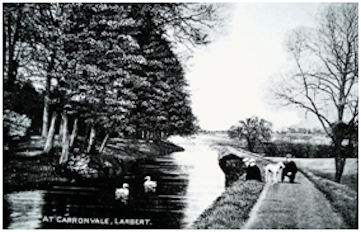
Illus 7: The Lade at Carronvale looking East.
The lade to the south had originally been used by the Carron Company to take castings from the foundry in the east to grinding mills in the west, and then to return them for onward delivery. By the 1850s this was no longer the case and some of the houses on its north bank were able to construct private bridges over it. They also sailed pleasure boats along it and in 1871 a boat owned by John Sherriff and moored at Carronvale had its lug sail stolen.
John Sherriff had his father’s mementoes at Carronvale which included a gold snuff box presented by Tsar Alexander and medals from Tsar Nicholas. He also had a handsome desk gifted by James Watt when he left the firm of Boulton and Watt for Russia. Fire was a constant threat to such items and in March 1884 a fire broke out in a bedroom in Carronvale House. The alarm was instantly raised and the gardener and a few willing hands succeeded in confining the flames to the room. Meanwhile the Falkirk Fire Brigade was telegraphed and arrived in the course of half an hour. They removed all of the burning material and in a short time the fire was out. A large mirror, the carpet and the woodwork and painting were destroyed giving damage estimated at £200.
Carronvale House was kept up to date and in 1890 John Sherriff erected telephone poles from Stenhouse to Carronvale. He was also instrumental in getting the county council to construct a footbridge at the ford across the River Carron in 1893.
John Sherriff was involved in the local community. He was an honorary president of the Stirlingshire Liberal Association, supported the Scottish Institution for Imbecile Children based at Larbert and was a member of the Glasgow and Stirling Sons of the Rock Society. He was also a Justice of the Peace. He often made financial contributions to these and other good causes and his wife and children helped with their time. His daughter, Margaret, did painting and her work sold well at church bazaars. She was one of the prime movers in establishing the Nursing Institution of Larbert Parish. In 1880 she married William Kinross Gair of Kilns House but died shortly afterwards. John Sherriff continued to support the local nursing association and left a bequest for that purpose.
John Sherriff continued to amass money from further investments. By the time of his death at the age of 75 on 5 November 1896 he had set up JB Sherriff & Company (Jamaica) Ltd to manage his sugar plantations and rum distillery in Jamaica. He had set up a trust to manage his affairs which also included investments in railways in the United States of America and South America, mines and shipping companies, and a considerable amount of property in Glasgow and central Scotland. The property included Stenhouse, bought in 1888, Kersie near Airth and Kingairloch in Ayrshire. Amongst the many gifts laid out in his will he left £20 to those servants at Carronvale who had been in his service not more than five years, and £40 to those who had been there longer.
Illus 8: Art Nouveau Water Hopper with the Date 1897.
George Sherriff inherited the estate. In September 1883 he had married Catherine Jane Nimmo of Westbank, Falkirk. Catherine and George went on to have six living children. Flora was born in 1887, John George in 1891, Edith Mary in 1892, Alexander Nimmo in 1885, Christopher Bell in 1896 and George in 1898. In 1888 George Sherriff had taken part of the Carronvale estate on the west side of Carronvale Road to build a large house designed for him by Thomas Lennox Watson in the English Arts and Craft style which he called Woodcroft.
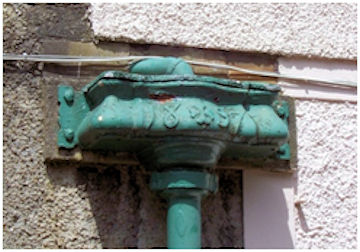
Upon inheriting Carronvale House he decided to modernise it and hired an old friend from his days at Blairlodge School to remodel it. This was the celebrated architect Sir John James Burnet. Work began in the summer of 1897 and was completed by 1900 when a series of record photographs were taken.

The work was undertaken in two stages. First the house was almost doubled in size by adding a storey to the wings and extending them and the central block further back to the north. This part of the house incorporated nurseries and a schoolroom. A short ‘tower’ was added to either side. The second stage was to add a servants’ wing around a “back court” to the east, including a new kitchen and offices. The opportunity was also taken to introduce gas lighting and the gas meter was fitted beside the lodge.
The building is deliberately skewed from the symmetrical and the use of single storey projections, a massive veranda, arched recesses and articulated bays combine to form a harmonious whole. The wide eaves, low pitched roofs, harled walls with ashlar-dressed margins and intricate window designs impart an art nouveau gloss to the former neo-Georgian building. The central door of the main façade remained the pilastered one with consoled cornices; the latter also feature on the ground windows on either side. Beyond these are the wide advanced wings with canted ground floor windows having centre lights with curvilinear rails over their casements. Above these the windows are bipartite.

Illus 10: Carronvale House looking north-east.
Around the corner on the west façade is one of the projecting two-storey pavilions, slightly taller than the main block, with pyramidal roof and ashlar upper storey. It is matched by one on the east front which replaced the dining room bay window. The boundary between the rendered lower section and the stone-faced upper is emphasised by a moulded stepped string course. The stonework is enlivened with squat Artisan Mannerist Ionic pilasters topped by urns in low relief. The French doors on the ground floor are given the same curvilinear rails as in the canted bays.
A further door from this point opened to the north into a broad veranda which cuts around the corner of the pavilion. This dominant feature has ashlar piers rising through its roof to finials carved with high-relief swags of flowers and fruits, including the pineapple, symbolising friendship.
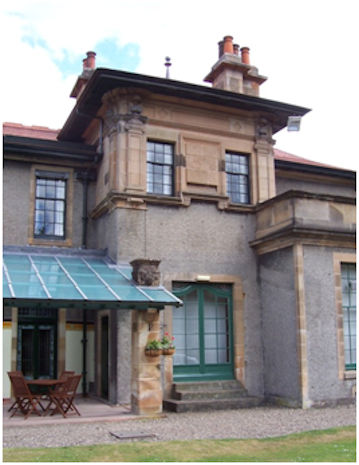

The record photographs from 1900 show that the roof of this veranda was originally made of glass. It provided a sheltered spot from which to catch the last of the day’s sunlight.

Illus 12: Carronvale House looking south east in 1900 (courtesy of the Boys’ Brigade).
The veranda returns around the north-west corner of the building as far as a small back door. The south side or the veranda has a dwarf wall between the piers with graceful curved gateways giving access to the croquet lawn and tennis court between the stable and the walled garden. A taller gateway opposite the back door led into the walled garden.

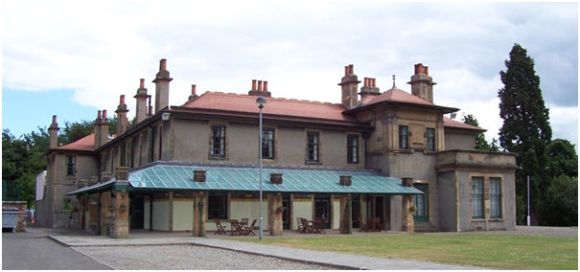
The servants’ wing was entered by a loggia of two round arches placed in a low two-storey bay set back from the east front of the main façade. To its east the service buildings around the inner court were of a single storey – the drop in height from the taller building being performed by a short length of balustrade and a sweeping curve downwards.


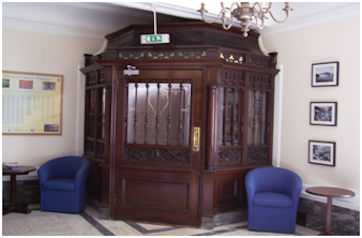
Illus 16: Porch.
Much of the original interior remains with finely executed woodwork throughout. Upon entry through the main door the visitor enters a small wooden internal porch occupying the south-east corner of the vestibule. The panelling has etched glass panes set behind mullion-like balusters with foliage and gryphons carved on the side facing inwards. Doric columns frame the inner door leading to the vestibule.

Illus 17: The Vestibule.
The floor of the vestibule is of veined marble, as is the large fire surround below an overmantel edged with paired Doric columns. The ceilings have deep plaster coving. The south-facing window lets light flood into the room. It is separated from the inner hall by an open wooden Jacobean screen carved with gryphons echoing the style of the porch. A double-leaf door leads to inner hall and the foot of the stair.
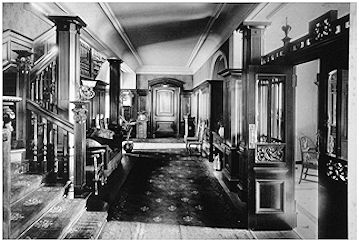

The inner hall with its high timber dado runs across the house like a corridor with the wooden stair along its north side partially screened by chamfered square fluted piers and the Jacobean balustrade. From this hall a number of architraved doors lead to the principal rooms.

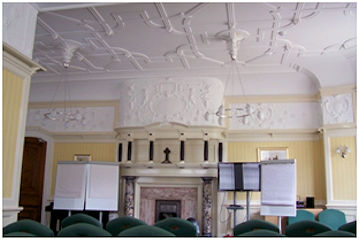
The first room on the left was the drawing room now used as a lecture room for conferences. Above a low dado the walls are divided by wooden slats into panels topped by a projecting cornice and a deep plaster frieze carried around the curved chimney breast. The frieze is heavily decorated with cartouches set in swags of fruit. The deeply coved ceiling has simpler geometric plasterwork with pendants. The large ornate fire setting is framed with tapering ‘marbled’ Doric columns supporting an overmantel with six squat miniature Ionic columns carrying an architrave with a broken pediment like a miniature temple. The chimney breast above sports plaster cherubs, gryphons, human heads and fruit around a central cartouche. On the south side of the room is one of the canted bay windows, and on the north-west French doors to the garden.



The next room to the north was the billiard room, its elongated shape emphasised by an oval centrepiece in the ceiling. On the west the three French windows look out onto the veranda. Opposite to them is the fireplace with lugged surround and prominent Doric tapering columns framing the overmantel.
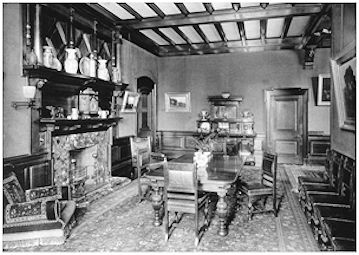
Illus 22: Dining Room.
Returning to the inner hall the first room on the right beyond the entrance was the study. It still has the Delft tile fire surround. The next room was the dining room with the second bay window at its south end. The ceiling has open wooden beams. The overmantel of the large fireplace is also of varnished wood and has three diamond-shaped panels set between spindle balusters. The fire surround below is marbled. Diagonally opposite it is a deep wall recess for the serving table or sideboard. This was the position of an earlier bay window and the ends of the ceiling beam which acts as a lintel are decorated with carved cherubs.
The decoration on the first floor is plainer. The upper landing acts as a transition and has a deeply coved ceiling crossed by beams supported on corbels decorated with plaster putti in high relief. Wooden screens at either end of the landing and a stained glass Art Nouveau stair window provide a strange contrast in styles.


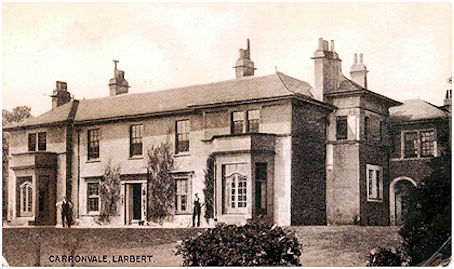
The small single-storey flat-roofed projection at the south-west corner of the house, enlarging the drawing room, was added shortly after the servant’s wing. It has a blank harled wall to the south topped with an ashlar parapet wall forming a continuation of that on the window bay. This continues on the west side where there is a bipartite window. It breaks up the more rigid symmetry which would otherwise apply.
Illus 24: The South Façade from across the Lawn. Note the absence of the western projection on the left-hand bay window.
Illus 25: The North Lodge.
As part of the new scheme the approach was modified. A long drive was led off to join Carronvale Road much further north, crossing the service drive to the west of the stables. A new lodge was built at the entrance. The North Lodge was probably also designed by John Burnet and bears his hallmarks of mathematical tiles on the upper portions of the gables and a half-timbered porch. It is L-shaped in plan. The main two storey block is set parallel with the road with a single storey wing projecting to it and the porch in the re-entrant angle maintaining a wary eye on visitors. The woodland was also extended to the east along the north side of the lade and gave the family the chance to indulge in its love of plants.

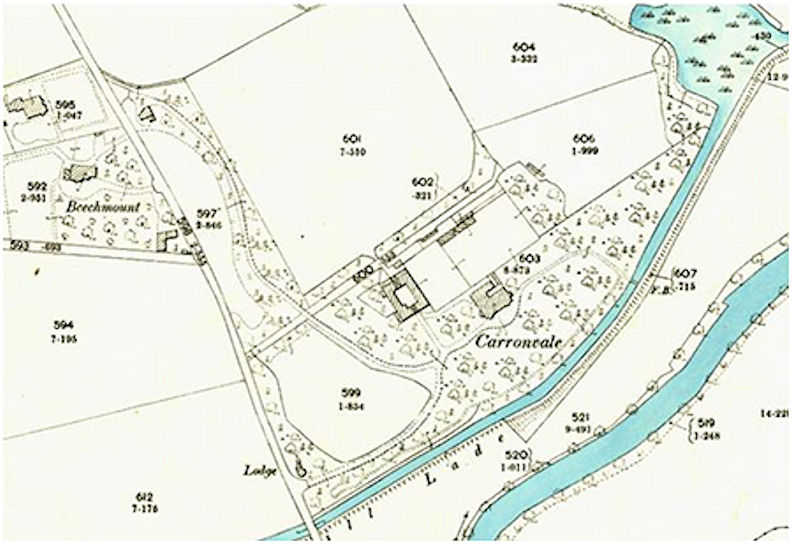
George played a leading part in the local community, as had his father before him. He represented Larbert Division for some years on Stirling County Council and he was a Justice of the Peace for the County. He was also a philanthropist. For example, he was a director of the Scottish National Imbecile Institution. He was a keen amateur photographer and the house included a photographic room. On his travels abroad he took many photographs and showed these in a series of lantern slide shows to the patients at the hospital as well as to societies in the area.
George Sherriff was well aware of the rising population of the parish and was happy to feu off parts of the estate to facilitate its growth and function. To encourage feuing he constructed roads and sewers through a portion of his estate near Larbert at a cost of £2,000, but it was some time before any interest was shown. In 1900 some 8.5 acres of Muirhead Farm were sold to the council for a cemetery. Tryst golf course was leased from George Sherriff in 1908.
As was common at this time the Sherriffs were happy to arrange for an annual servants’ supper and dance at Carronvale each New Year. In 1901 a large erection was built at the back of the house for this purpose and decorated with Chinese lanterns.
In January 1904 Flora Sherriff exhibited some of her sketches for the first time at the annual exhibition of the Falkirk School of Arts. They were studies of the Bedouin natives in the desert which she had seen on her travels with her father – she was only 17 years old. She did not stick to one medium. Five years later it was a loch scene in oils that was on display and in 1911 etchings, followed by a water colour the year after. For local historians her best-known work are the pen and ink sketches that she executed in 1907-8 for Gibson’s book on the estates of Larbert and Dunipace. Not surprisingly George Sherriff had a great sense of history and encouraged John Gibson to publish it.

Illus 27: Oil Painting by Alexander Fraser (Glasgow Museum).
Carronvale House was full of paintings. One of these, “A Highland Croft” by Alexander Fraser, was gifted to the Glasgow Museums in 1946. It can be seen opposite the fireplace in the photograph of the dining room taken in 1900 and had been in the house since the 1850s. Inventories of the house refer to many oil paintings, watercolours and drawings scattered throughout. These included works by James Faed, WC Faed and Horatio McCulloch.
Around 1907 a new lodge was built at the end of the old service drive and was included in the valuation of £125 for Carronvale that year. The lodges provided accommodation for the gardeners. The pleasure grounds were further extended to the north-east around this time with an enclosure in the centre for a vegetable garden to replace that lost to tennis.

An aerial photograph of c1920 provides a vivid view of the house and its immediate grounds. On the left are the stables, then a tennis court, croquet lawn, walled garden with hothouses and greenhouses. Beyond an avenue of beech trees is the vegetable garden. The house in the centre has a veranda opening onto a lawn on the left, and the single-storey servants’ wing on the right.

A sundial from Stenhouse, now owned by the Sherriff’s, was moved to Carronvale and placed at the centre of the walled garden – it too can be seen on the aerial photograph. The tall tapering pillar upon which it sat, and the stepped plinth, were probably made for this move.
Illus 30: The Carronvale/Stenhouse Sundial drawn by Flora Sherriff.
George Sherriff died on 10 Nov 1908 aged 52 and the estate was run by his wife and a trust. In September 1911 John George Sherriff, the eldest son, came of age and there were many celebrations. However, the First World War was looming. During the war the officers of the 8th Battalion Scottish Rifles (Cameronians) were billeted in the stables of the Carronvale House. Four of the Sherriff brothers served in the armed forces and two were killed. The memorial in Larbert Churchyard bears the following inscription:
“ALEXANDER NIMMO his second son/ 2nd Lieut., Northhamptonshire Regiment/ Born 13th August 1894 killed in action near Ypres/ 1st November 1914 and buried in a wood near Hooge/ JOHN GEORGE, his eldest son/ Lieut. 7th Argyll and Sutherland Highlanders/ Born 24th August 1890, killed in action in Flanders/ 25th April 1915, and buried in a field near St. Julien“

Christopher Bell Sherriff joined the army on 7 December 1914 and was commissioned as a 2nd Lieutenant in the 11th Service Battalion of the Argyll and Sutherland Highlanders but on 11 October 1915 he was transferred to the Army Service Corps – possibly because of the death of his two brothers. On his death at the age of twenty-four John George Sherriff’s personal estate had been worth £80,000 and unexpectedly Christopher now inherited. By the end of the war he held the post of Acting Captain. In 1918 his younger brother, George, took a commission in the Royal Garrison Artillery and was sent to France where he was injured. After the war Captain C B Sherriff was made the commanding officer of C Company Argyll & Sutherland Highlanders and attended many meetings, including annual events in the Drill Hall in Falkirk.
The Scottish distilling business had to be sold, but the Jamaican business continued. By 1921 the company owned at least five sugar plantations in Trelawney Parish, Jamaica. These were Long Pond, Parnassus, Hyde Hall, Steelfield and Etingen. There was a central factory at Long Pond for the distilling of rum. Christopher Sherriff made several trips to Jamaica, but the day-to-day running of the Jamaican business was in the hands of agents.
On 15 November 1928 Christopher married Elizabeth Mary Greig in Paisley Abbey and they set up home at a Craigmarloch in Kilmacolm. Carronvale House was still occupied by Christopher Sherriff’s mother, Catherine. She died there on 16 February 1936. She was well respected and had been an office bearer for the Falkirk & District Royal Infirmary, as well as a long time president of the Larbert Parish and Carron District Nursing Association.
Lt Col Christopher Sherriff decided not to leave Craigmarloch and his brother, George Sherriff, occupied Carronvale for a short time, probably to clear up the affairs. In the 1930s and 1940s George went on a series of plant collecting expeditions to the Himalayan regions of Tibet and Bhutan, bringing back many previous unknown specimens, many of which are now in the Natural History Museum.
The sales particulars from 1936 are lodged in Falkirk archives:
“The subjects consist of Carronvale House, Garden, Vegetable Garden, Amenity timber, and arable land… “stabling for 5 horses, small stable for one horse, and Loose Box. There is a Garage for two cars, and two garages for one car each, squash court, workshop, harness room, store room and Coal cellar… The Gardens consist of two subjects. A walled garden adjoining the house is reserved for flowers and fruit trees and the hot houses are situated there. The vegetable garden lies a few yards to the east, screened by a beech hedge. The glass houses consist of a Fern house, Cold house and Potting shed all in one range, Peach house, Melon house, Tomato house, Vinery and conservatory, small rockery near vegetable garden.”
(a1847.011).
By the end of the year Carronvale House was acquired by the Prudential Assurance Company and was used to store records. It also had a wary eye on the political situation in Europe. It became obvious that the estate lands would be available and so in August 1939 Stirling County Council approached Christopher Sherriff’s agents, who indicated that he would be prepared to consider a price of £12,000 for Carronvale and Crownest, including the minerals, but excluding the Bog Park and a piece of land along Carronvale Road containing the two lodges.
There was a flurry of activity in late 1939 when at short notice the claims department of the Prudential was transferred from London to Carronvale House and it became their divisional headquarters. The staff were quartered in the house and for almost five years became part of the local scene, joining the Home Guard, helping in fundraising and doing the Dobbie Shuffle in the Dobbie Hall. It may have been at this time that the glass roof of the veranda was replaced by a more traditional wooden one covered in red felt tiles.

In 1944 the Carronvale Riding Club was formed at the stables of Carronvale House and became quite active, arranging fund raising events and a gymkhana. Winter lectures were held in the harness room and in the summer months the group rode to villages throughout Stirlingshire.
At end of the war the Prudential Assurance Company put the property on the market.
“For sale by private bargain, the mansion-house and policies known as CARRONVALE HOUSE, LARBERT, situated in own grounds and within easy access to shopping centre, railway and bus stations. The substantial well-built, two-storeyed residence contains 5 public rooms, billiard room, 9 bedrooms and dressing rooms, 3 bathrooms, servants’ hall, 5 maids’ bedrooms and bathroom, laundry, and ample domestic accommodation with gas and electric cookers; electric light and central heating. Policies extend to 12 ½ acres and comprise productive walled garden, kitchen garden, hothouses, with vinery, wooded grounds, entrance drive, and lodge; hard and grass tennis courts; stabling and garage for 4 cars. Early possession. For further particulars and appointment to view, apply THE PRUDENTIAL ASSURANCE CO., LTD., Carronvale House, Larbert.”
(The Scotsman 26 July 1945, 1).
It was considered as suitable for an old person’s home by the County Council but it decided that the asking price of £6,000 was too high. In August 1946 it was announced that the Boys’ Brigade had bought Carronvale House for their Scottish headquarters for use as a conference and training centre. By May 1947 the conversion of Carronvale House was almost complete and it was officially opened on 28 June 1947 by Lord Home. Football pitches were placed in the walled garden and these were replaced in 2015 by floodlit all-weather pitches.
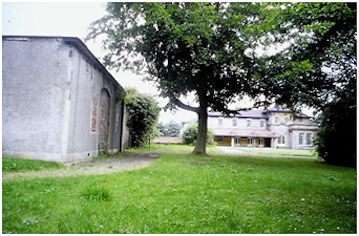
Illus 32: Carronvale House with the old Stable Block on the left, 1998.
The buildings have changed in line with the times. A rather ugly upper storey was added to the servants’ wing around 1970 to provide additional bedroom accommodation. The stable block, which had been occupied in 1944 by the Riding Club, fell into disuse and was demolished. Some of the walls remained until 1998 when construction began on a recreation and conference centre which was opened by Lord Steel on 6 May 2000. Shortly thereafter, in 2003, the house was refurbished. En suite facilities were provided for most of the bedrooms and the roof repaired. The glass roof of the veranda was also reintroduced. A service of rededication was held in April 2004
Despite these changes the grounds immediately surrounding the house have stood like an oasis of green in a sea of change. The original lodge has been extended and the old drive blocked. The frontage onto Carronvale road has been completely built up all the way to the North Lodge and beyond, engulfing the North Drive. The fields to the north of the service drive are also occupied by housing.
Carronvale House is a beautiful building, but it is a private one. Occasionally it is open to the public through events such as Doors Open Days and is well worth a visit. Its ownership over the centuries can be summarised as follows:
| 1777 | Alexander Brown |
| 1800c | James Brown (son) |
| 1819 | Duncan Robertson of Roehill (purchase) |
| 1824 | Duncan D Robertson (son) |
| 1857 | John Bell Sherriff (purchase) |
| 1896 | George Sherriff (son) |
| 1908 | John G Sherriff (son) |
| 1908 | Christopher Bell Sherriff (brother) |
| 1936 | Prudential Assurance Company Ltd |
| 1946 | Boys’ Brigade |
Sites and Monuments Records
| Carronvale House | SMR 209 | NS 8671 8198 |
| North Lodge (57a Carronvale Rd) | SMR 1645 | NS 8645 8212 |
Bibliography
| Gibson, J.C. | 1908 | Lands and Lairds of Larbert and Dunipace Parishes. |
| Gifford, J. & Walker, F.A. | 2002 | The Buildings of Scotland: Stirling and Central Scotland. |
| Reid, J. | 2007 | ‘The Feudal Land Divisions of East Stirlingshire: the Lands and Baronies of Larbert,’ Calatria 24, 1-36. |
G.B Bailey (2020)

